|
|
||||||||||||||||||||||||||||||||||||||||||||||||||||||||||
|
Please sign my Guestbook and leave feedback |
||||||||||||||||||||||||||||||||||||||||||||||||||||||||||
|
Recent Additions |
||||||||||||||||||||||||||||||||||||||||||||||||||||||||||
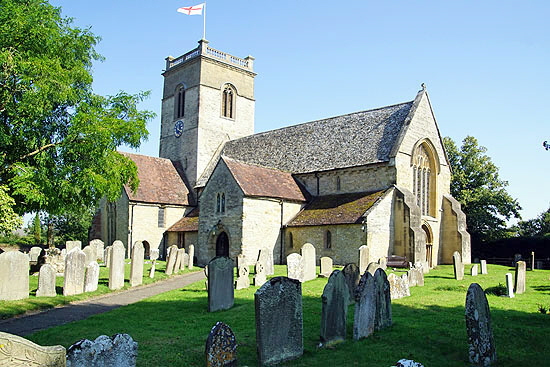 |
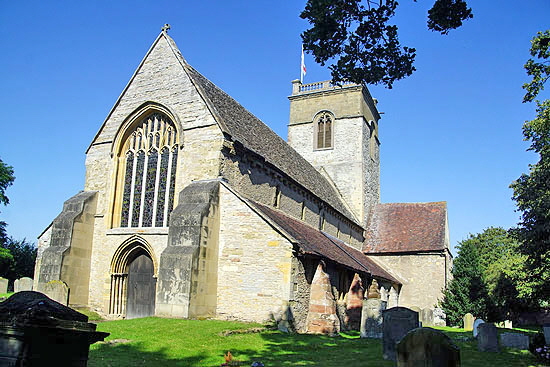 |
||||||||||||||||||||||||||||||||||||||||||
|
Left: The church from the north west. The basics of the church are late Norman. Note, for example, the sparsely windowed clerestory and the very shallow and steeply pitched aisle. The tower is central, although that is not obvious from this picture. Its lofty height tells you that it has been extended upwards since Norman times. The transepts too are original. Right: The church from the south west. The Perpendicular west window is, of course, a later addition. The west doorway is, however, original and in the Transitional style. The buttresses are particularly ugly on both west wall and south aisle. Later builders were often only guessing what sort of foundations Norman masons had provided. |
|||||||||||||||||||||||||||||||||||||||||||
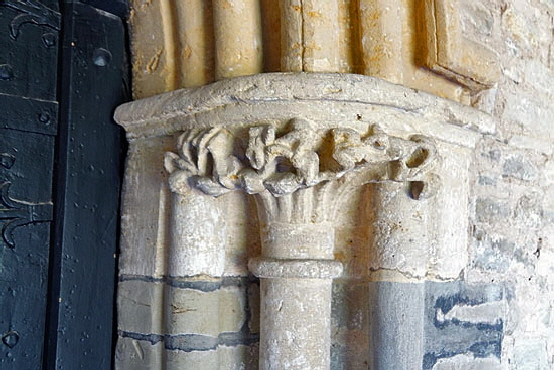 |
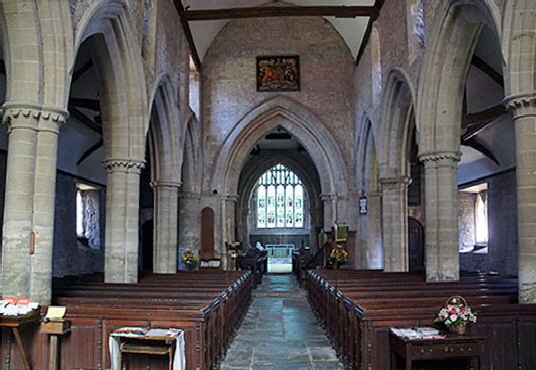 |
||||||||||||||||||||||||||||||||||||||||||
|
Left: The stiff leaf capitals of the west doorway. Right: Looking towards the east end via the tower crossing. The symmetrical arcades are finely carved and lofty. One surmises it was the work of masons well-versed in the new Gothic styles even as early as 1190. |
|||||||||||||||||||||||||||||||||||||||||||
 |
 |
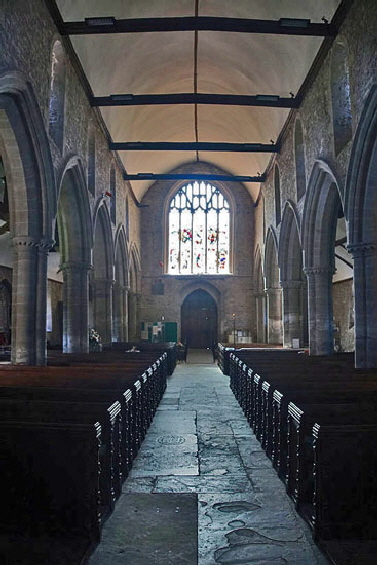 |
|||||||||||||||||||||||||||||||||||||||||
|
Left: The south door with its rounded arch bearing testament to its twelfth century origins. Note the similarities between the capitals of the south and west doors. Yet the west door has a much more sophisticated form with five orders of moulding, clearly the original main door. Centre: The chancel was rebuilt in the thirteenth century. Right: The view to the west. |
|||||||||||||||||||||||||||||||||||||||||||
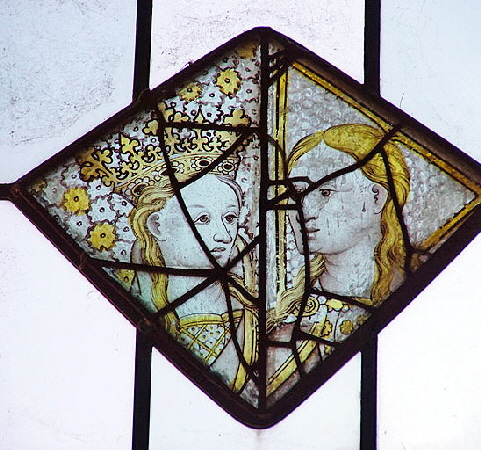 |
|||||||||||||||||||||||||||||||||||||||||||
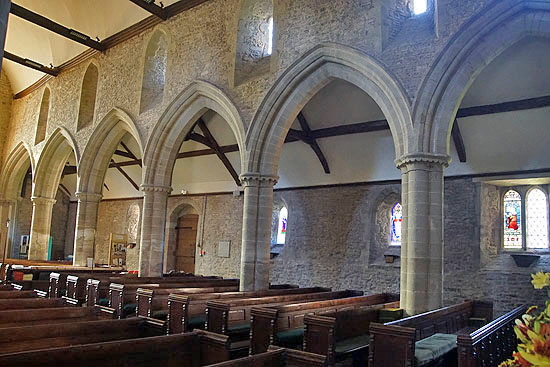 |
|||||||||||||||||||||||||||||||||||||||||||
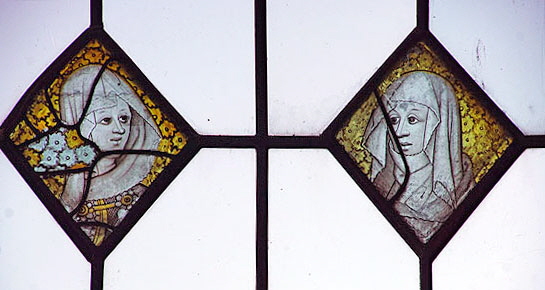 |
|||||||||||||||||||||||||||||||||||||||||||
 |
|||||||||||||||||||||||||||||||||||||||||||
|
Top Left: Looking to the north west. The arcade really is noble for its time. The clerestory, oddly, is rather a throwback. The windows are rather larger and more numerous than the average Norman clerestory. They are also slightly pointed, reflecting their Transitional nature and very similar in profile to those visible in the aisle. This must have seemed a very light and airy church to the parishioners of the time. Top Right and Lower Left: There are some lovely fragments of fifteenth century glass that survived a fire during the Reformation. Lower Right: One of the two banks of stalls with misericords facing each other across the width of the chancel. |
|||||||||||||||||||||||||||||||||||||||||||
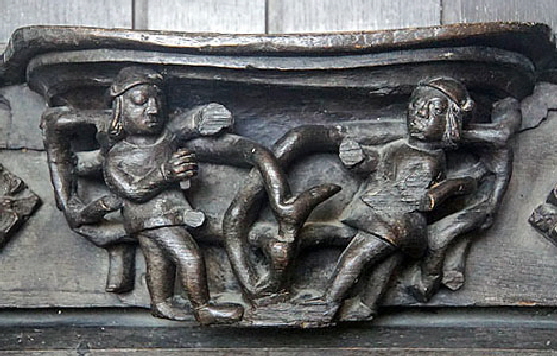 |
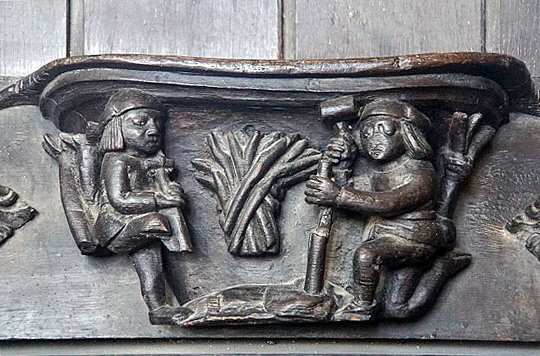 |
||||||||||||||||||||||||||||||||||||||||||
 |
|||||||||||||||||||||||||||||||||||||||||||
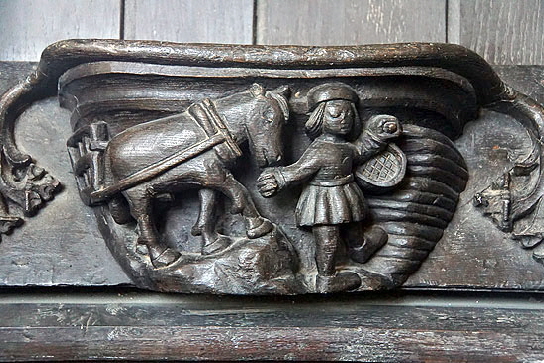 |
|||||||||||||||||||||||||||||||||||||||||||
|
So to the Misericords. In the tradition of “labours of the month” fonts and Norman wall painting twelve of them show rural activities associated with each month. There is a lot of stuff talked about those acting as some kind of “education” or “reminder” for the peasantry but that always seems to me to be nonsense. So those people who spent their lives on the land, who mixed only with others who laboured on the land and who were required to work on the manorial lands in exchange for their tenancies needed educating by the Church then about what to do each month then? Snort! Anyway, these misericords post-date the Norman church itself by three hundred years or more. In showing these “labours” the carpenter was simply representing the lives of those that lived in Ripple, year after year. It was the only life the people knew. As always, they give us a lesson in the peasant dress of the day. There is no allegory here; no symbolism; no Christianity except to the extent that manual labour was A Good Thing for the souls of those who performed it. Which was quite convenient for the better-off members of society, of course. This is the first four. Top Left: January - Collecting wood. Top Right: February - Hedging and ditching. Lower Left: March - Sowing the crops. The horse is rather an odd shape but the carpenter has made a great job of the hooves. The man carries a basket of seed in his hand. Lower Right: One of the four natural influences in the crops - the Sun. |
|||||||||||||||||||||||||||||||||||||||||||
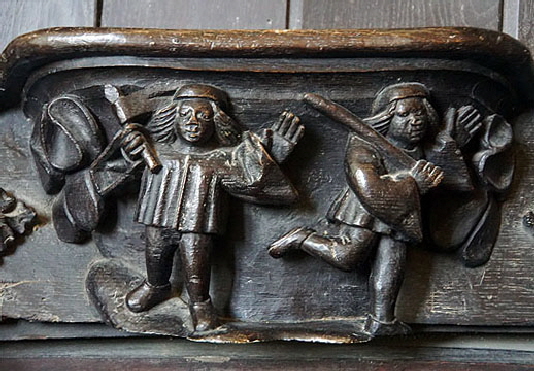 |
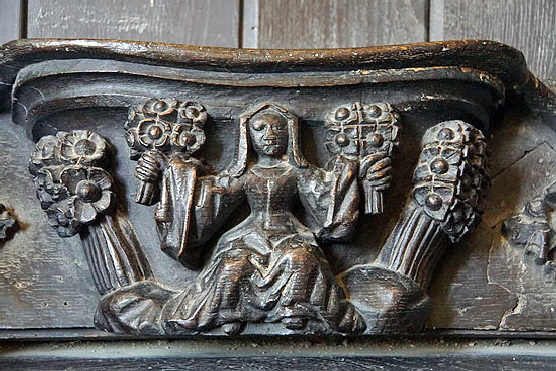 |
||||||||||||||||||||||||||||||||||||||||||
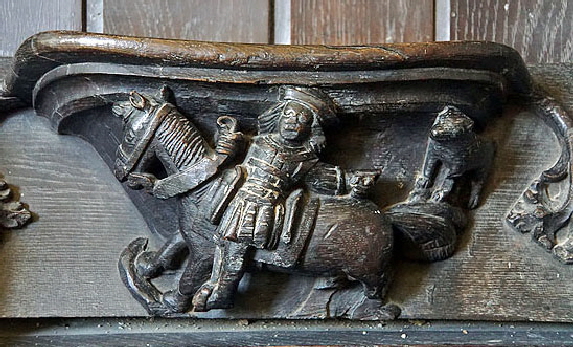 |
|||||||||||||||||||||||||||||||||||||||||||
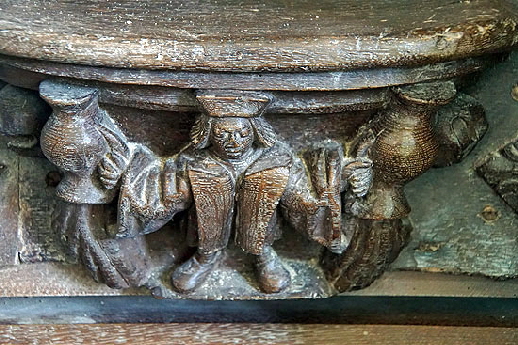 |
|||||||||||||||||||||||||||||||||||||||||||
|
Top Left: April - Bird Scaring. You’ve no sooner sowed you seed than those pesky birds are there eating eat. Incidentally. the propensity of local lords and landowners, not to mention monasteries, to keep large flocks of doves and pigeons for food was a real issue for the peasantry whose seed was apt to fatten the birds for the pot! Top Right: May - My personal favourite - Rogation Sunday and the blessing of the crops. Do you have a diary that has a day mysteriously called “Rogation Sunday”? Well it was a very important occasion in the mediaeval world, the meaning of which is now largely lost to us. I once took a woman to a restaurant for Sunday lunch as a first date. Eager to impress with my erudition and wit I made her a mock Rogation Day card (Clinton Cards surprisingly not having yet tapped into the obvious potential). She didn’t get the joke - yes, it was feeble - and wanted to talk about golf and dogs, two of the only subjects under the sun about which I have nothing to say (what - you’ve noticed?). Well apart from the Ryder Cup, that is, and she knew nothing at all about that. There was no second date, needless to say. .Lower Left: I thought this was some bloke who’d had a bit too much to drink and was falling off his horse but apparently it is June - Hawking. This, it hardly needs saying, was not a pursuit for the peasantry and the clothing is much finer. The hawk, sadly, has been broken off. Note the dog to the right. Lower Right: I got this one wrong too. I thought it was some bod with a raging thirst and a tankard in each hand. The same bloke who had been falling of his horse in June perhaps. But no, it is Aquarius spreading water not ale. Thus, it is another of the influencing factors on the crops - rain. You have to admit he does look much more like a pub landlord than a Babylonian god. |
|||||||||||||||||||||||||||||||||||||||||||
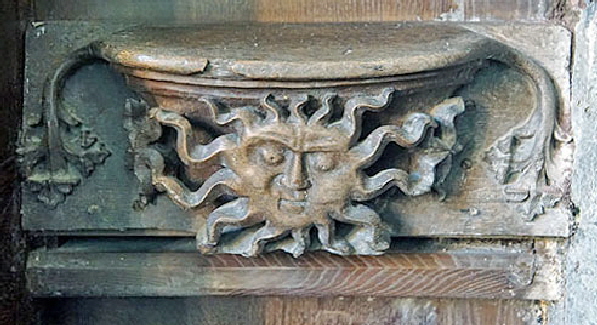 |
|||||||||||||||||||||||||||||||||||||||||||
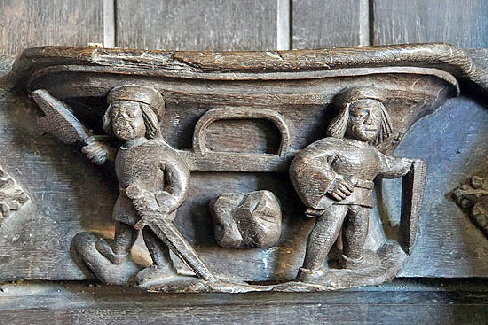 |
|||||||||||||||||||||||||||||||||||||||||||
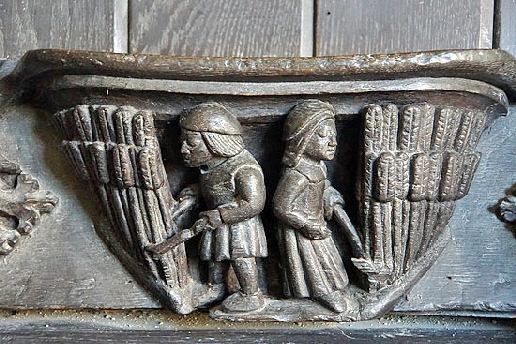 |
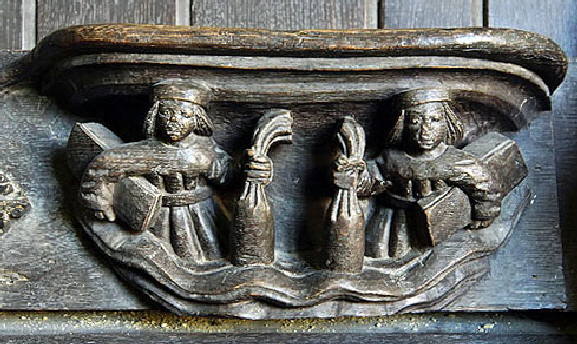 |
||||||||||||||||||||||||||||||||||||||||||
|
Top Left: The sun makes another appearance, this time signifying warmth rather than light. Top Right: July - Lammas. This is an interesting one and Ripple claims it to be unique. ”Lammas” is a corruption of Loaf Mass which dated from Anglo-Saxon times. It was an ancient tradition to celebrate the first loaves made with the new wheat. In the background is the mouth of the oven and there is a loaf underneath it. The man on the left is holding a bread paddle used for putting the dough in the oven and removing the finished loaves. The right hand figure is broken. Note that both men are standing on an uneven surface. I believe this represents the practice of working large quantities of dough with the feet. Lower Left: August - Reaping. The man on the left is using a sickle while the woman on the right has a crook. Lower Right: September - Corn for malting. Each man holds a sheaf in one hand and a long corn bin in the other. |
|||||||||||||||||||||||||||||||||||||||||||
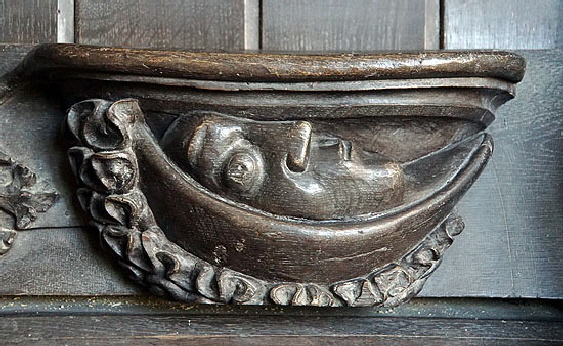 |
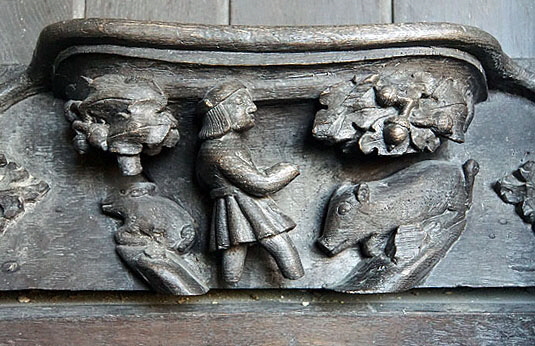 |
||||||||||||||||||||||||||||||||||||||||||
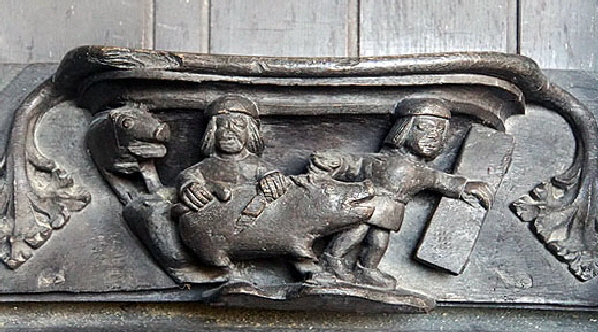 |
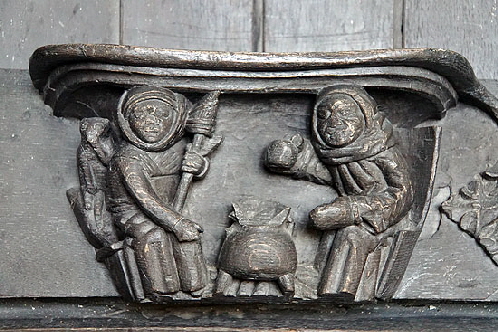 |
||||||||||||||||||||||||||||||||||||||||||
|
Top Left: The Moon - the last of the crop “influencers” although today we might question what effect the moon has on agriculture. It’s a rather wonderful depiction, demonstrating how long the “man in the moon” fancy has been around. Top Right: October - the man has lost his stick but he would have been beating down acorns the feed the pigs. It is now Autumn and the emphasis has moved now from arable pursuits. Lower Left: November - It’s a bad time to be a pig. One man is holding a pig by the tail and another is being held by the ear whilst a third looks on aghast. Lower Right: December - The man (right) is settled in a curved seat by the fire upon which a pot simmers. His goodwife spins. |
|||||||||||||||||||||||||||||||||||||||||||
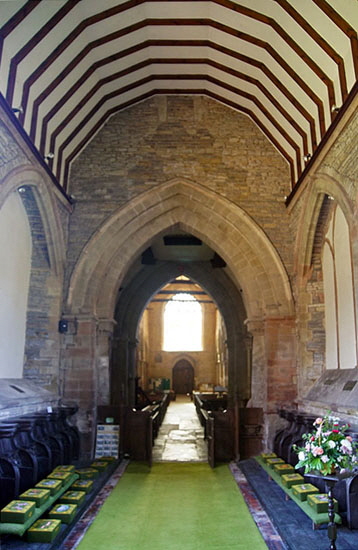 |
 |
 |
|||||||||||||||||||||||||||||||||||||||||
|
Left: Looking west from the altar, past the banks of misericords to left and right into the tower crossing and beyond. Centre: A blocked doorway in Transitional style. Right: A completely different style of doorway, emphasising the state of architectural flux at the time the church was built. |
|||||||||||||||||||||||||||||||||||||||||||
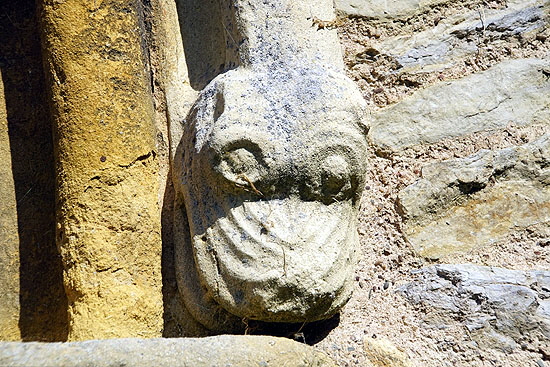 |
|||||||||||||||||||||||||||||||||||||||||||
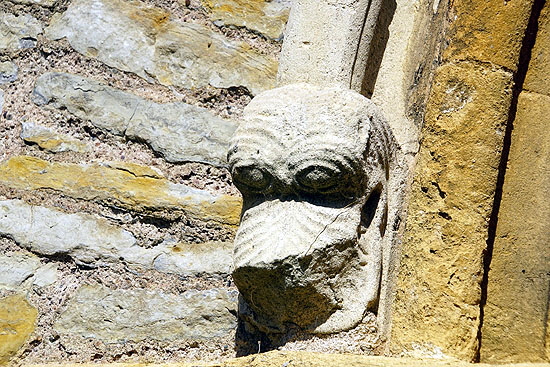 |
|||||||||||||||||||||||||||||||||||||||||||
|
Left and Right: On the south doorway there are preserved chunky Norman style hood-mould stops with ribbed faces and very typical of this area. |
|||||||||||||||||||||||||||||||||||||||||||